Lectric XPeak 2.0 Review | The Fat Tire Value King?
The XPeak 2.0 has an impressive blend of performance and versatility; the value of the ride is hard to match.
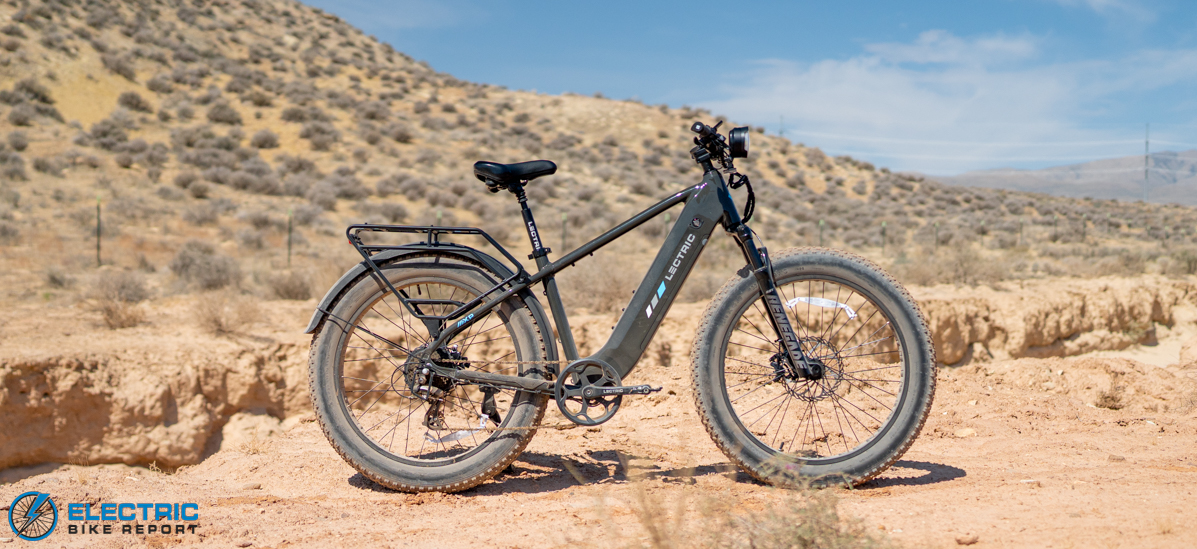
Fat tire e-bikes are coveted for their power and versatility. Their wide tires make for comfortable riding on paved roads and add a bit of a wild side, as the chunkier tread pattern and broader surface area help you navigate rough or loose terrain without sliding around or losing control.
Lectric’s XPeak 2.0 delivers all the hallmarks of a good fat-tire bike but manages to put its own unique spin on the experience while also offering better features than you’d expect at its price point.
The motor experience is a standout. The XPeak 2.0 has plenty of power, but its unique delivery, thanks to the brand’s in-house torque sensor, is what truly sets it apart. Even a light turn of the cranks moves you along with ease, but the bike rewards harder pedaling with more power. It creates a relaxed, natural ride feel even at low power levels, making this 80+ pound bike surprisingly easy to maneuver.
Many of the 2.0’s upgrades improved its handling. The XPeak’s frame feels stiff and superbly confidence-inspiring, while its drivetrain, handlebars, and tires work together to help you climb hills, navigate turns, and ride comfortably. The brakes offer better value and performance than before, and nice quality-of-life improvements like a sharper aesthetic and a color display are much appreciated.
The XPeak 2.0 handles both paved and unpaved roads well, making it a reliable choice for daily commuting or exploring.
When you stack its spec sheet against the competition, anything that matches it spec-for-spec typically costs hundreds more, making the XPeak 2.0’s value hard to ignore.
Its shortcomings are typical for such an affordable ride: sizing covers most riders but is somewhat limited, and while other Lectric models offer color options, this one locks you into either white or black (depending on whether you choose the step-thru or high-step model).
Even so, these minor drawbacks don’t take away from what the XPeak 2.0 offers. It’s fun to ride, loaded with features, priced lower than most competitors, and performed great throughout our testing. For all the details, see the full testing breakdown below.
Class 3 (pedal assist to 28 mph)
 Pros
Pros- Great motor performance. The M24 hub motor is powerful, quick, and has a surprisingly quiet ride.
- Tremendous value. The XPeak 2.0 offers solid performance, a few standout components, and still costs less than most competitors.
- Confident off-road feel. A stiff frame, massive tires, and a higher-quality fork (for a budget-priced bike) help the XPeak 2.0 handle chunky, bumpy terrain.
- On-road comfort. Much of what helps it off-road also makes it comfortable on-road, with wide tires for balance, a fairly upright riding posture, and a well-sized handlebar for easy steering.
- Great motor engagement. Lectric’s custom cadence/torque hybrid sensor gives solid motor support whenever the cranks move, with extra power when you push harder.
- Solid drivetrain. The gear range prevents ghost pedaling at high speeds, and the trigger shifters are a noticeable upgrade over the previous generation’s over-the-bar design.
- Battery range/options. Range test results exceeded expectations, and it’s great to have two battery sizes to choose from to fit your needs and budget.
- Great optional extras. Lectric offers unique accessories at checkout, including winter riding gear and fishing equipment.
 Cons
Cons- A drawback of the ultra-low price, it has limited sizing options. Only available in one high-step and one step-thru frame.
- Also, limited color choices. Color options are tied to the frame style you pick.
- Battery: 48V 15Ah (720Wh), removeable; Upgraded 20Ah (960Wh) for $200 more
- Display: A backlit color LCD display with a USB-C port provides trip and battery intelligence on the go. IP-65-rated electrical components ensure greater water and dust resistance.
- Motor: M24 750W rear hub-motor (1310W peak), 85Nm torque, stealth tech for quiter experience
- Headlight: Included
- Taillights:included, powered off the bike’s battery
- Pedal Assist: PWR+ programming (torque/cadence sensor hybrid system), 5-level pedal assist
- Claimed Range: Up to 60 miles (standard battery)
- Throttle:Thumb lever
- App:No
- UL Certification:2271 & 2849
- Claimed weight: 64.5 lbs (without battery
- Tested Weight:84.4 lbs (ST, with battery), 81.3 lbs (HS, with battery)
- Rider height range:5’2” – 6’3” (ST), 5’4” – 6’5” (HS)
- Total payload capacity: 330 lbs
- ST Standover Height: 19.5”
- Brakes:2-piston hydraulic, 203mm rotor front, 180mm rotor rear (1.8mm thick)
- Fenders:included, plastic
- Fork:RST Renegade 80mm spring fork
- Frame: 6000 aluminum, ISO 4210-10 eMTB standard-rated, high-step or ST frame
- Drivetrain:8-speed Shimano Altus, 46t chainring, 11-32 tooth cassette
- Grips: Ergonomic lock-on grips
- Saddle: Lectric custom
- Handlebar: 600 mm alloy
- Kickstand: included
- Pedals: Quick-release pedals, metal pins
- Tires: Chaoyang 26” x 4” knobby tires, slime included

The XPeak 2.0 is a solid ride on both paved and unpaved areas.
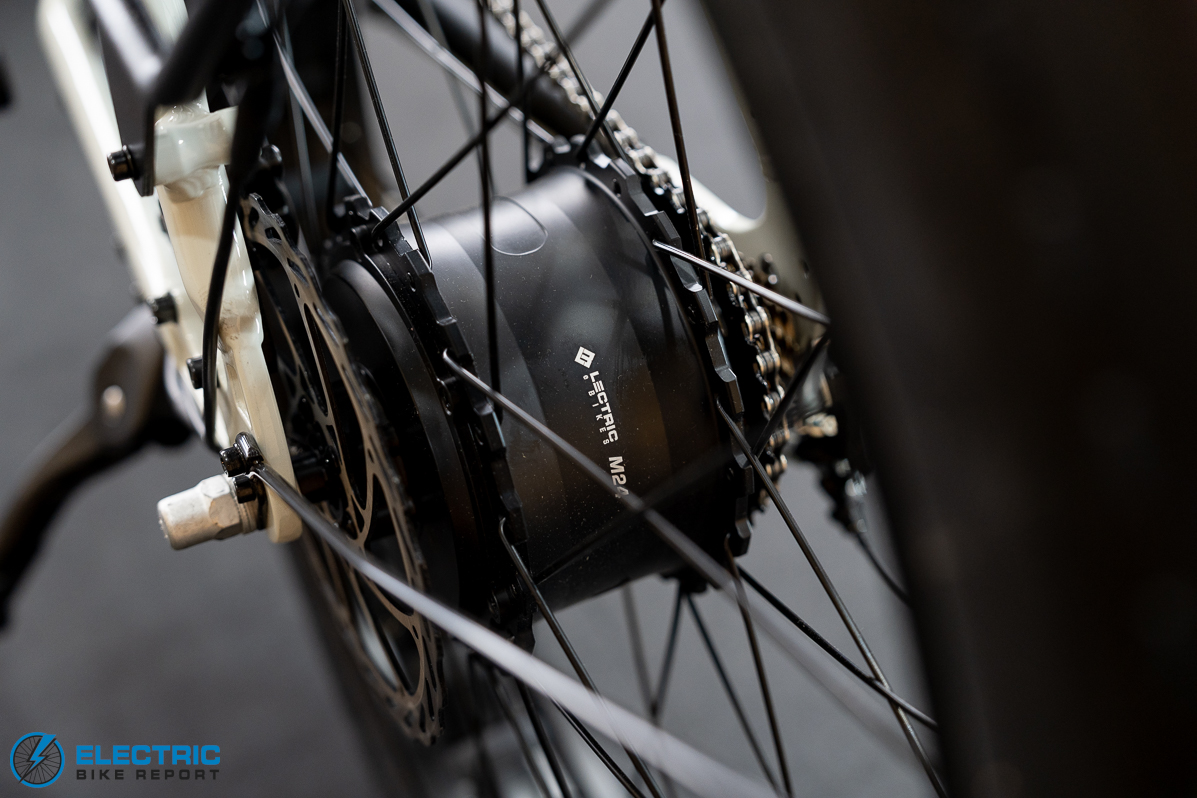
Lectric’s own motor has great power, but it’s far quieter than what’s on most fat bikes.

The battery, which comes in two sizes, integrates nicely into the frame and is removable for charging.
Lectric XPeak 2.0 Review: Model Options
The XPeak 2.0 is available in two frame styles, each with a single frame size. Lectric touts the ST model, with its 19.5” standover height, as being best for riders from 5’2” to 6’3”. The high-step option is suited for those slightly taller, ranging from 5’4” to 6’5”. These differences made sense to us based on the ST’s slightly shorter reach and seat tube.
Interestingly, the ST model is a couple of pounds heavier than the HS model. With a thicker down tube and gussetted frame, Lectric clearly took appropriate steps to stiffen the ride!
The XPeak is available in two colors that are dependent on the frame style; the ST model is available in Stratus white, while the high-step comes in Tempest Grey.
Lectric XPeak 2.0 Review: Speed Test
Lectric’s PWR+ programming is unique to them—it blends elements of both cadence and torque sensors. As long as the cranks are moving, the motor delivers some power. But the harder you push, the more it gives back. It’s a hybrid system I’ve really come to appreciate, especially on a big, heavy, fat bike like this. It smooths out the ride, making it easier to get going than a typical torque sensor while still offering a much more natural feel than a pure cadence system.
When it comes to the speed capabilities of the XPeak 2.0, the results were almost exactly what I hoped to see, with just one small drawback.
In most cases, e-bikes with torque sensors do not limit the speeds of each pedal assist setting, allowing the rider to pedal up to the bike’s maximum speed with varying levels of effort. The XPeak, however, limits its speeds in PAS 1 and 2 to 9 and 15 mph, respectively.
While PAS 2’s limit was more generous, the watt drop off in PAS 1 made it feel a bit impractical or limited in real-world use, as conservative riding should still be closer to 10 mph (in my opinion, anyway).
That small gripe aside, the rest of the PAS levels felt fairly well-spaced and purposeful. Even where PAS 4 and 5 are fairly close together on flat ground, I could still feel a difference when riding up hills, which kept both levels useful.
Additionally, it’s worth noting that the PAS 1 and 2 limitations can be changed through the bike’s relatively cryptic (you’ll want to keep the manual handy) display menu. The lowest assist levels are limited by default, with the throttle tied to the PAS, but users have the option to unrestrict PAS 1 and 2 while keeping the granular throttle control or free both the throttle and PAS from all restrictions (except the maximum settings).
Overall, the XPeak’s Speed Test performance was definitely more good than bad. The motor is seriously quiet—something that’s not always the case with heavy, fat-tire bikes that tend to strain motors and generate more noise. But even at higher top speeds, the XPeak 2.0 stayed surprisingly hushed.
It also handled impressively well at top speeds. Many e-bikes start to rattle or feel unstable when pushed close to 30 mph, but the XPeak 2.0 stayed solid as a rock.
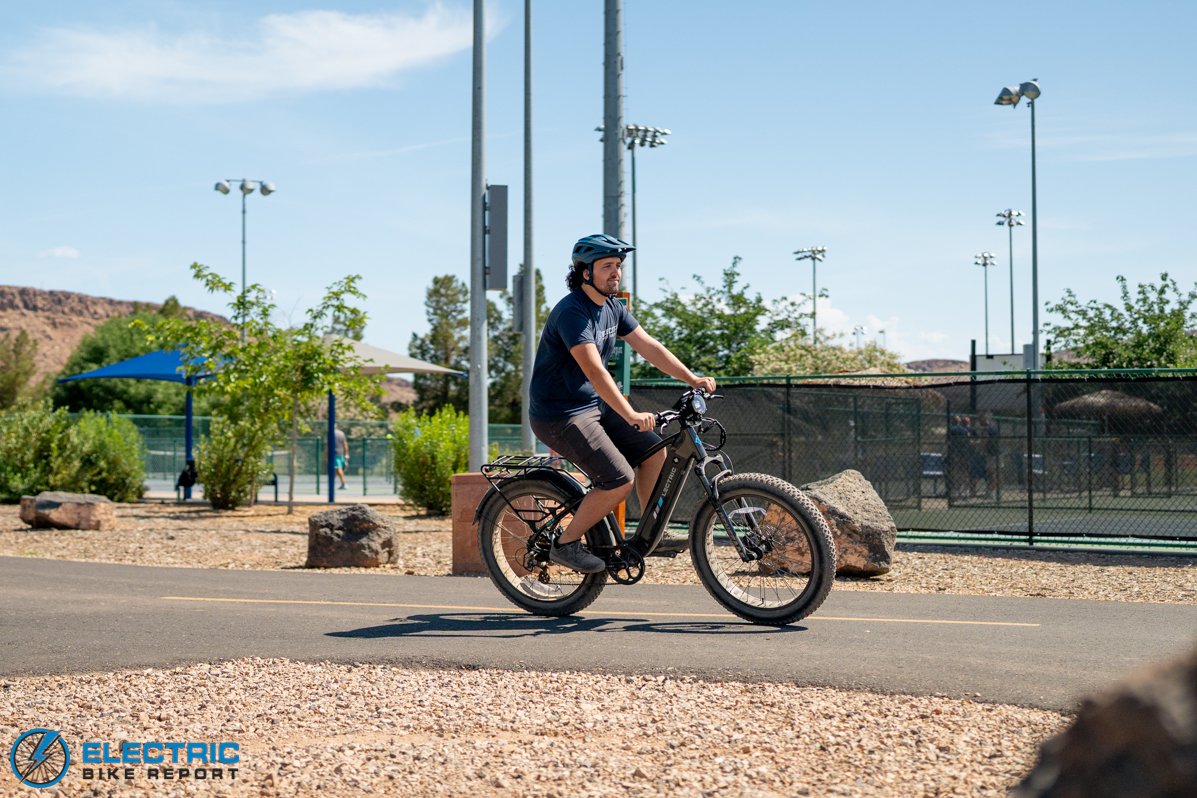
The geometry of the bike strikes a balance between relaxed and aggressive, making it comfortable to ride to work daily while also feeling suitable for playing in the dirt.

While I’m not a fan of bar-based battery readouts, the display is large and easy to read.
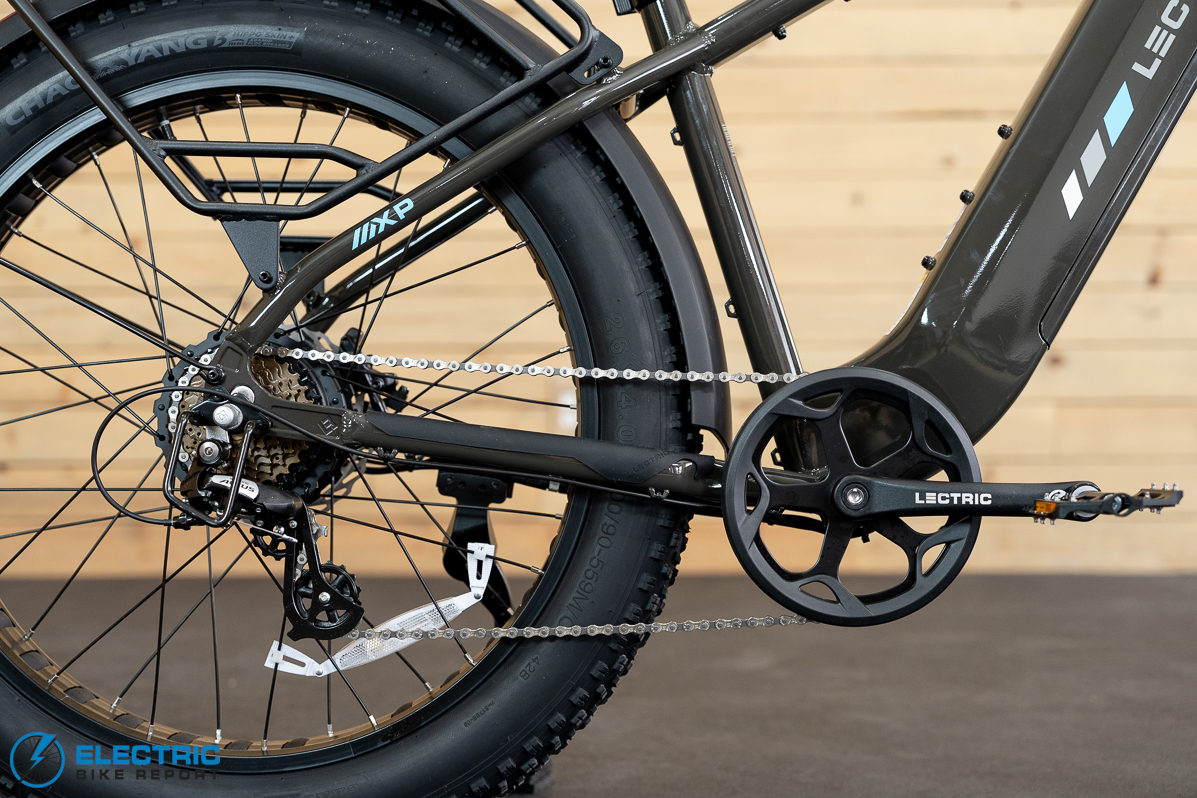
The 8-speed drivetrain is appropriately geared, allowing you to climb hills and pedal at speeds of up to 28 mph.
Lectric XPeak 2.0 Review: Range Test
With the XPeak 2.0, Lectric claims a range of up to 60 or 80 miles, depending on which battery you choose. We were sent the larger 20Ah (960Wh) battery for testing, so we were eager to see if it could deliver on those long-range promises.
In our max power test (PAS 5, Class 2, 20 mph), the bike lasted for 46.1 miles. After recharging, we ran it again on low power (PAS 2) and reached 65 miles. That’s a little shy of Lectric’s claimed 80-mile range, but since we used PAS 2 instead of PAS 1, so I won’t ding them for that.
Using those results and a bit of math, we’d estimate around 34.6 to 48.8 miles on the standard 15Ah (720Wh) battery. Of course, your mileage may vary, but that gives a solid ballpark to work with.
Overall, these are a mix of good and great results. The low-power test matched the average efficiency of other fat tire e-bikes we’ve tested. The watts-per-mile during the low-power test were pretty standard, but the high-power test stood out. We typically see bikes use about 25 watts-per-mile on max assist, but the XPeak only used 21. That’s impressive efficiency when it comes to battery consumption.
That efficiency speaks to the bike’s PWR+ programming. It gives you strong support when you need it—like getting up to speed or climbing hills—but then eases off to maintain speed without draining the battery unnecessarily.
Everyone has their own idea of what qualifies as “good” range, but personally, I think a floor value of 46 miles on the 20Ah battery—or an expected 34 miles with the standard battery—is pretty solid.
Lectric XPeak 2.0 Review: Hill Test
A big draw of any e-bike is how it handles hills. To measure that, we take every bike we test to the infamous Hell Hole Trail—a paved, third-of-a-mile climb with an average grade of 12 percent.On the throttle-only test, the XPeak made it to the top in 1 minute and 20 seconds, averaging 13.6 mph. That’s better than the all-bike average of 1:34 and even edges out the fat bike category average of 1:22 as of this writing.
With pedal assist in PAS 5, the time improved slightly to 1:15, with an average speed of 14.5 mph. Again, that beat the all-bike average of 1:28 and tied the fat bike average.
So let’s keep it simple with a basic analysis here: When it comes to flattening hills, the XPeak 2.0 does a great job. It’s got more than enough power to make steep climbs feel easy.
Beyond the test, I admit I was surprised with how well the bike adapted to hills offroad. I spent the better part of a day along a mountainside with several steeper climbs, and with the right use of gearing, it moved much quicker and easier uphill than I originally expected from a heavy e-bike.
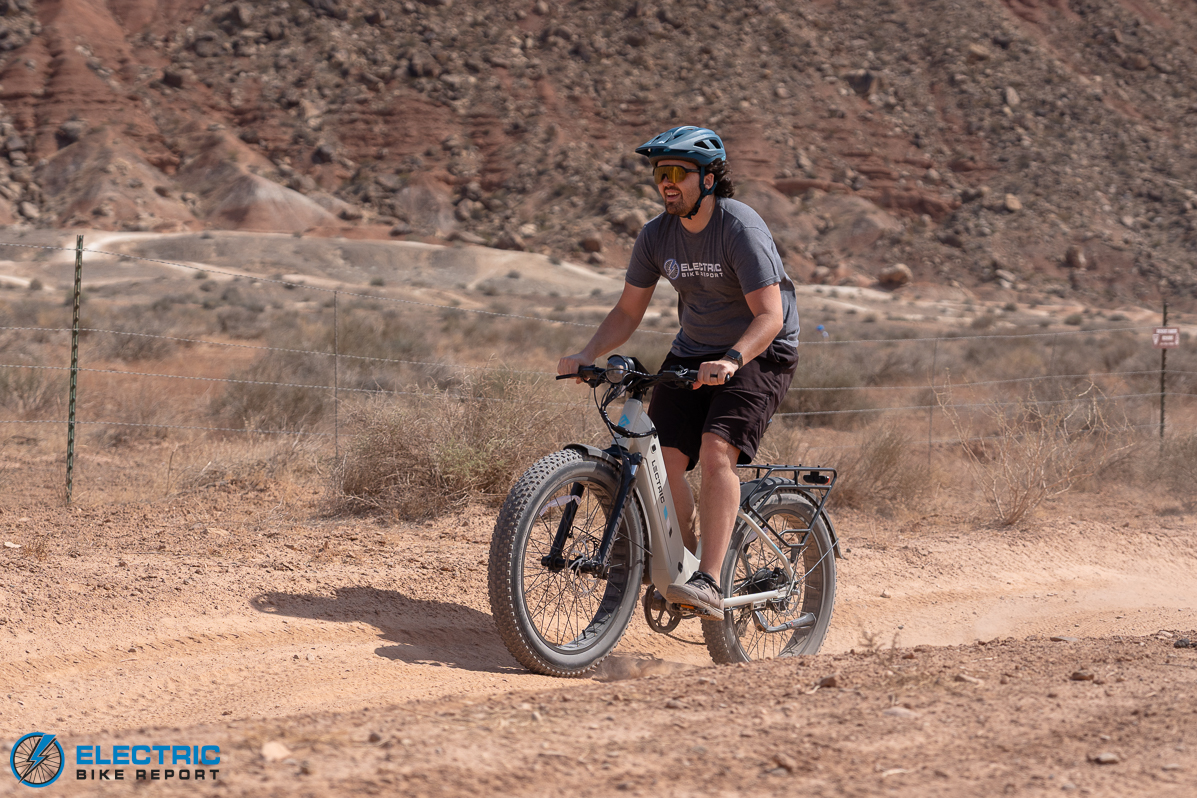
The XPeak 2.0 has eMTB durability ratings, so it’s plenty tough for rides over chunky rock, dirt, and gravel. It’s not an eMTB by any stretch, but it’s surprisingly capable for fire roads, double-track, and mild singletrack.

The 203mm rotor performed well and slowed the heavy bike down with no problems.
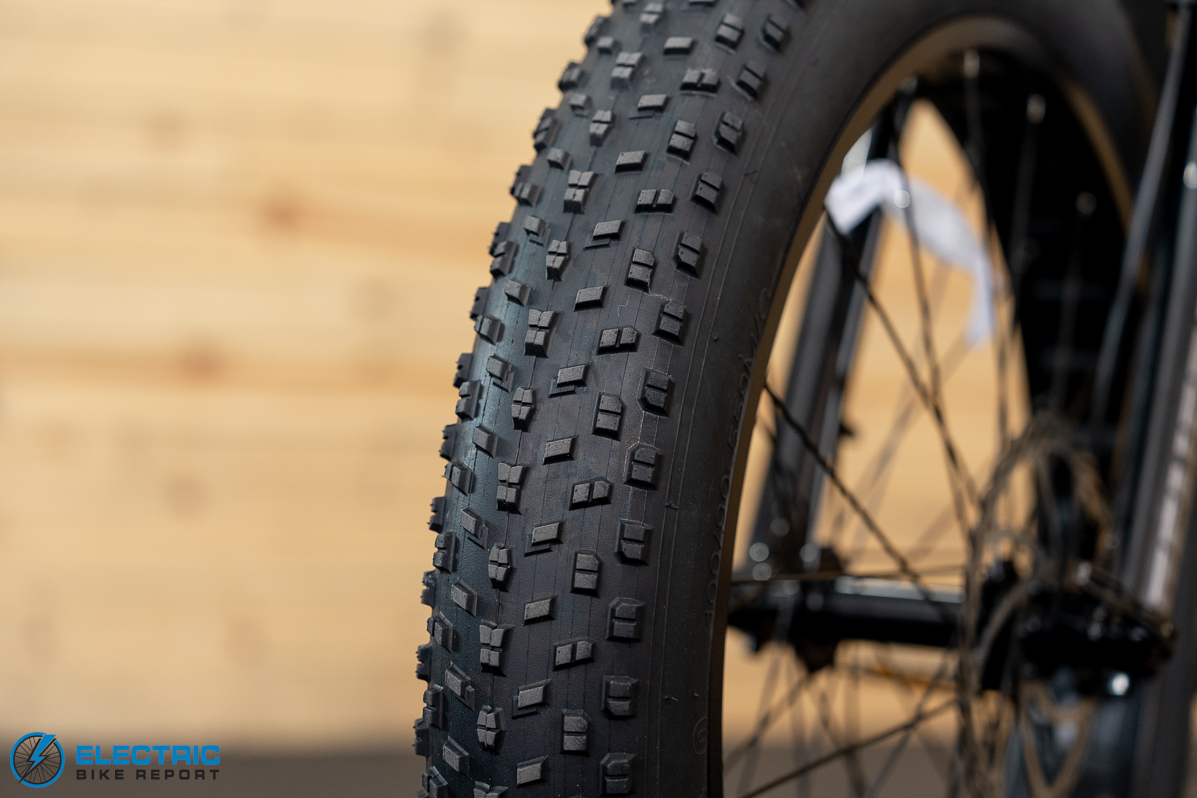
The Chaoyang 26×4” tires have some tread for better traction off-road, and it’s nice that they come with Slime pre-installed.
Lectric XPeak 2.0 Review: Brake Test
To measure how well the brakes performed, we conducted a test as outlined in the graphic above. I was happy with the XPeak’s results as it was able to stop at an average of 22’5”. That just so happens to be the fat bike’s category average as well. The high-step model, which we tested separately, had an even better average result of 20’7”!
One of the key upgrades from the original XPeak to the 2.0 is a larger front rotor, moving to a 203mm rotor instead of a 180mm. That extra surface area helps dissipate heat more effectively, which improves braking performance.
In fact, the 2.0 stopped 7 inches shorter than the original model—even more impressive considering this version of the bike is heavier than the XPeak 1.0 we tested, due to the upgraded battery we were sent this time around.
As part of the continued theme of the XPeak 2.0, the larger rotor is another example of how Lectric has added more value without raising the MSRP. So, in the brake department, it’s a win for both performance and value.

Lectric’s large, upgraded 850-lux headlight helps with visibility at dusk.
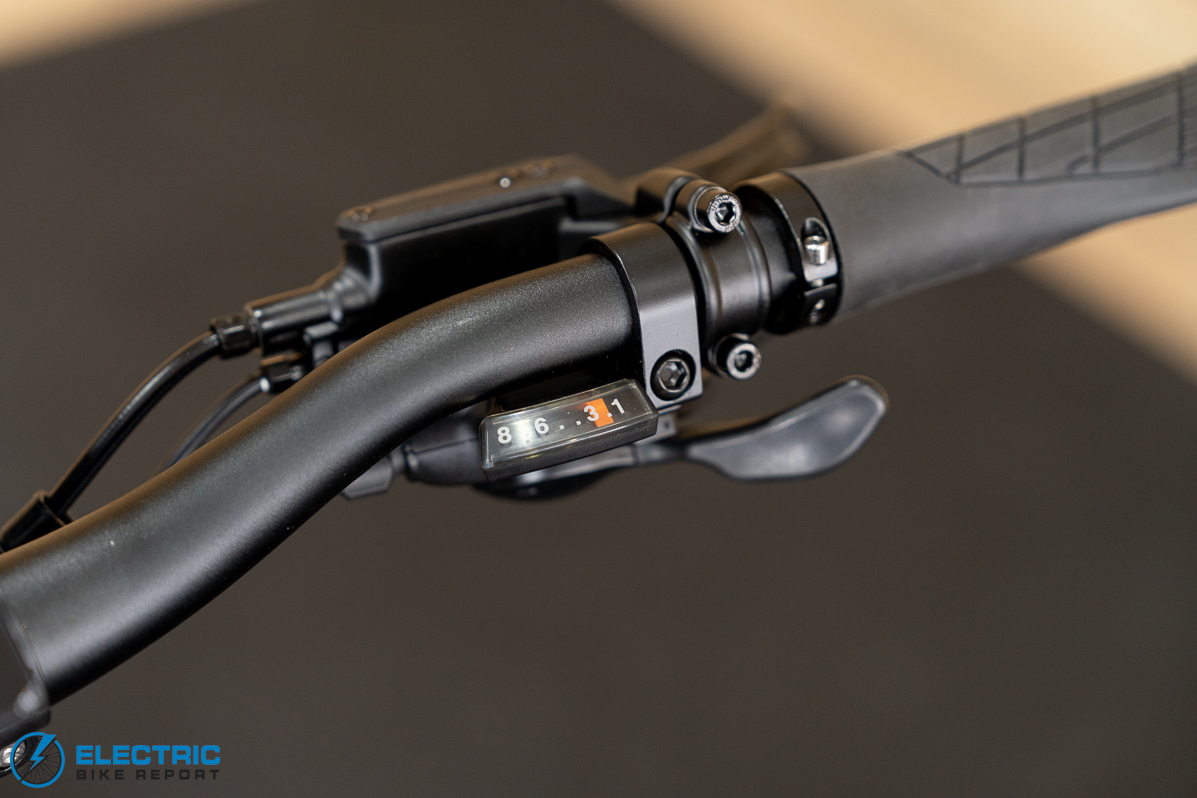
Arguably the best upgrade from the 1.0 to the 2.0, the rapid-fire trigger shifter feels great when shifting on bumpy rides.
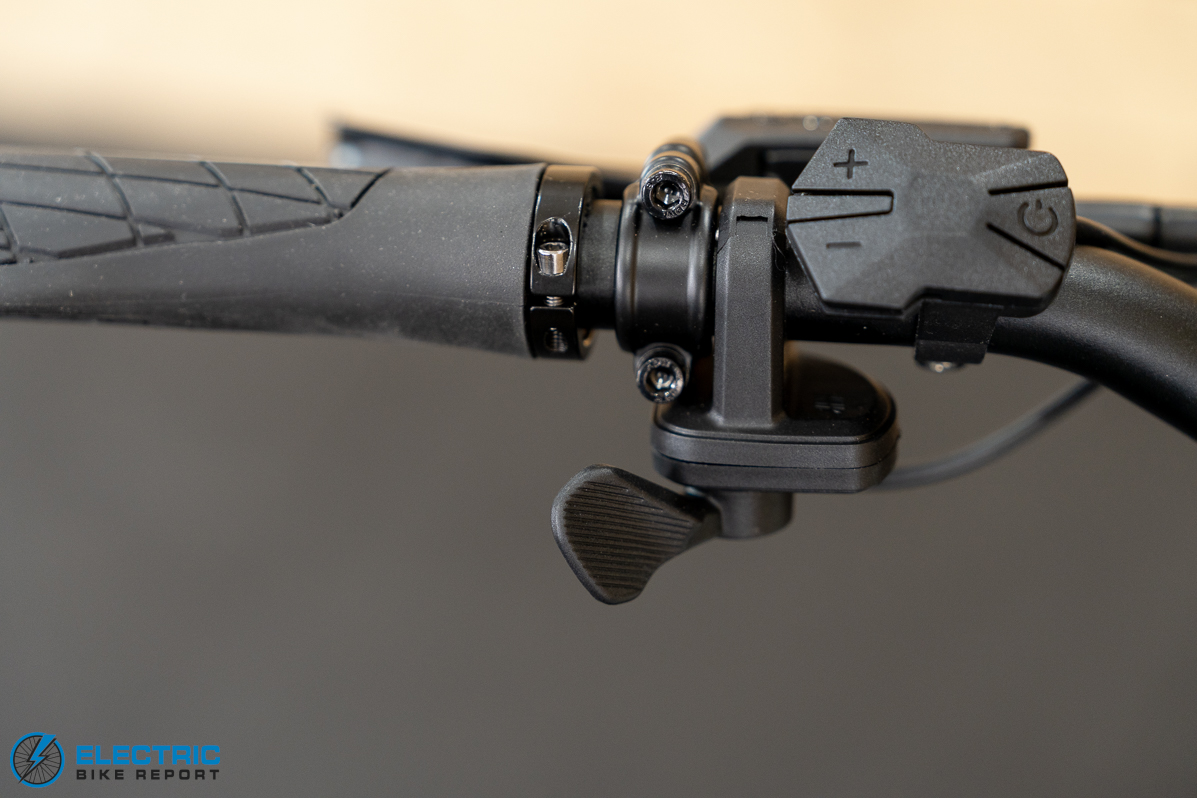
The sideways thumb throttle is nice as it minimizes accidental engagement of twist-grip throttles.

The RST Renegade fork is of much better quality than we’d expect on a sub-$1,500 bike. The fork alone goes for $400+!
Lectric XPeak 2.0 Review: Ride Quality
“Ride quality” can be a little vague, but it largely comes down to how the bike looks and feels. Let’s start with the feel.
The XPeak 2.0 rides with a lot of confidence. The 600mm handlebar appeared a little narrow on paper, but paired with the wide tires, it gave the bike a very solid feel. It’s not twitchy, nor does it feel too wide. With this setup, you can cruise, commute, or romp off-road, all with relative ease and while maintaining good control of the ride.
The tires are great for the balance they provide on paved roads, although they do come with a noise penalty—you’ll definitely hear them on pavement. But they pay off big time when you cut through dirt or gravel. They float over loose terrain easily and can boulder over rocks and roots on milder trails.
The RST Renegade fork performed nicely, too. It softened the ride wherever I took it and helped the XPeak 2.0 earn an ISO 4210-10 rating—the eMTB durability standard. So while no, this isn’t a full-blown mountain bike, that durability rating provides some real peace of mind that the frame, fork, and components can handle rough roads, doubletrack, and fireroads.
The 2.0 also got a lot of quality-of-life upgrades over its predecessor, and they all paid off. We already covered the PWR+ programming and upgraded brakes, but there’s also a stiffer frame, an upgraded 8-speed drivetrain, and a new color display.
The frame and drivetrain upgrades were noticeable. Describing frame sturdiness can be tricky, but it mostly comes down to how confident you feel when turning, riding over rough patches, and handling bumps. I’d say the XPeak 1.0 felt “mostly confident,” while the XPeak 2.0 feels “very confident” across a variety of terrain, even on the step-thru frame.
The drivetrain upgrade from seven to eight gears is great, but the switch to rapid-fire trigger shifters was a night-and-day improvement. I’m not a fan of over-the-bar shifters on bikes meant to handle rough terrain, so this change was a huge step forward in my eyes.
Even the smaller details around the edges stood out. I like the sideways thumb throttle, which helps prevent accidental engagement, and the quick-release pedals with pins that keep your feet planted firmly where they should be.
Lectric also offers plenty of usual accessories like fenders, racks, and lights, but you can also choose from a variety of less common optional extras like fishing packages or winter riding gear if you want to ride year-round.
If the XPeak 2.0 has a downside, it’s a familiar one for bikes that keep costs low: sizing is limited to one high-step and one step-thru model. It’s a little more limiting still since the black and white color options are tied to the frame type you choose.
Still, I’ll give Lectric credit for their progress in styling. The frame angles, branding, and overall look are sharper and crisper than on previous bikes. It’s the kind of improvement I hope to see as a brand matures, and Lectric is clearly growing in that regard. While they’re still making affordable bikes, their designs are starting to look a lot less like budget rides.
Lectric XPeak 2.0 HS vs ST Version
We tested both the high-step and step-thru models of the XPeak and found that both had a similarly sturdy, sporty, and comfortable feel.
With a lower minimum saddle height, a low standover height, and a shorter reach, the ST model is geared toward shorter riders. The HS frame is better suited for taller folks due to its high standover height, taller saddle, and longer reach. A rider of the same height moving between both bikes will notice a slightly more upright riding position on the ST model.
Both frame styles felt solid and well-built, though, as with any bike that offers both a HS and ST frame, the high-step had a stiffer feel overall. We noticed some frame flex on the ST (again, unavoidable due to the nature of not having a top tube), but its ride was a noticeable improvement over the ST version of the XPeak 1.0.
Overall, the differences were minimal, so if you’re leaning toward the ST for ease of use but concerned about frame flex, I’d say that you shouldn’t be worried.
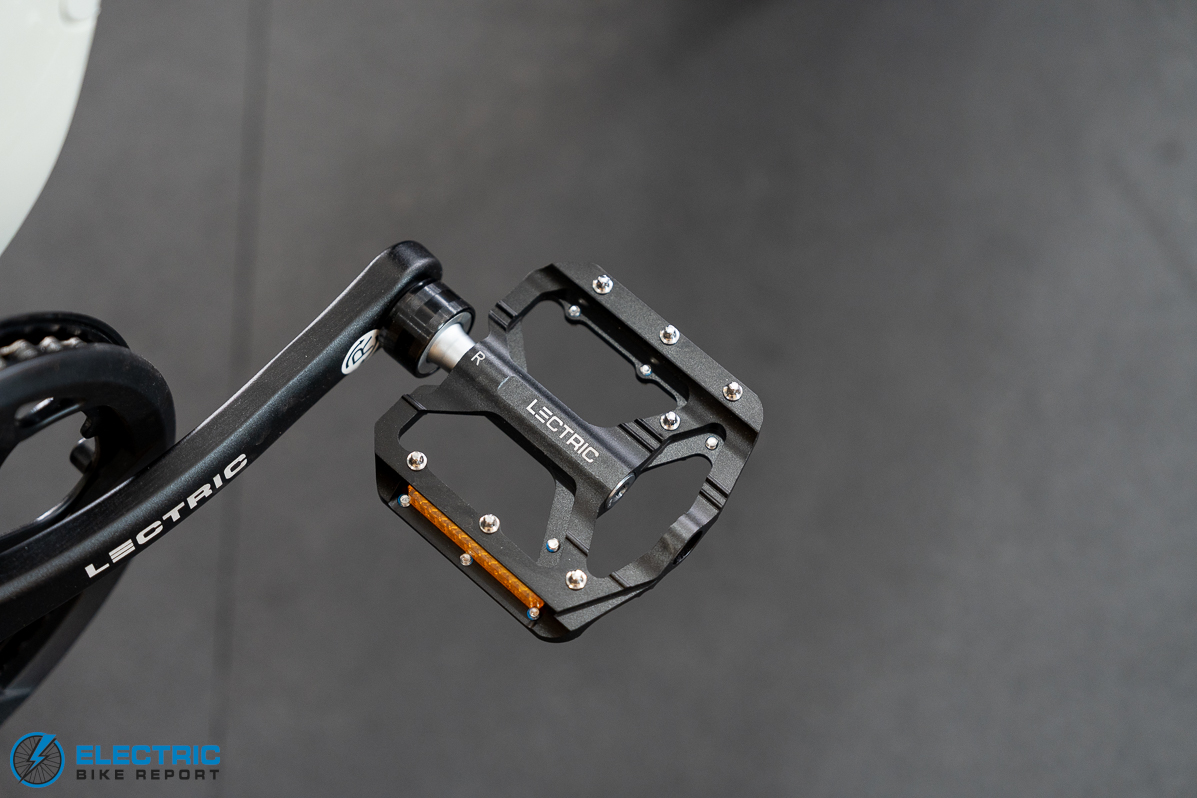
The quick-release pedals are made for easy assembly and keep feet in place along bumpy roads.
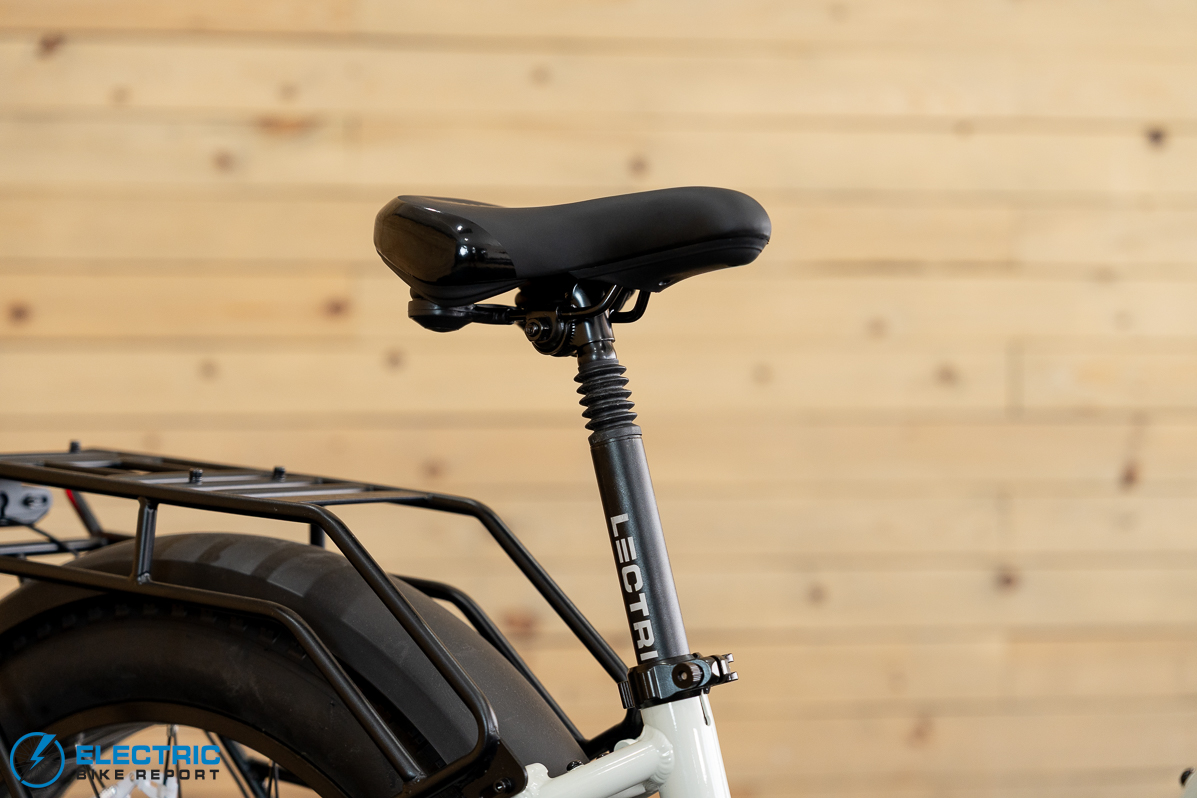
One of the perks of our upgraded battery model is that it came with a springy 40mm suspension seatpost.

Even the ST frame felt relatively stiff, thanks to a reinforced gusset.

For the commuters: a 60 lb capacity rear rack and an included taillight.
Lectric XPeak 2.0 Review: Summary / Where to Buy
The e-bike community is constantly debating which fat tire bike is the best, but I don’t know if there are many that can truly challenge the Lectric XPeak 2.0 when it comes to offering the best value in the category. It has all the hallmarks of a good fat tire e-bike and then some.
Across all our standardized tests, the XPeak 2.0 performed as well as or better than other fat tire e-bikes we’ve reviewed. But it costs less, and it comes with components and durability certifications you simply don’t see on bikes under $2,000, let alone well under that threshold.
The motor delivered strong power, the ride felt stable and confidence-inspiring, the shifting was intuitive, and most importantly, it was just plain fun to ride!
This is a bike we happily recommend to riders looking for a budget-friendly ride with on- and off-road potential. It could be a stable and powerful commuter, a versatile adventure bike, or just about anything in between.
Happy Riding! Make sure to let us know if you have any questions or if you think we left anything out in this review of the Lectric XPeak 2.0 down in our comments section.





thanks for the write up – this bike looks really good. having a hard time between this, aventure 3, and nomad 2.